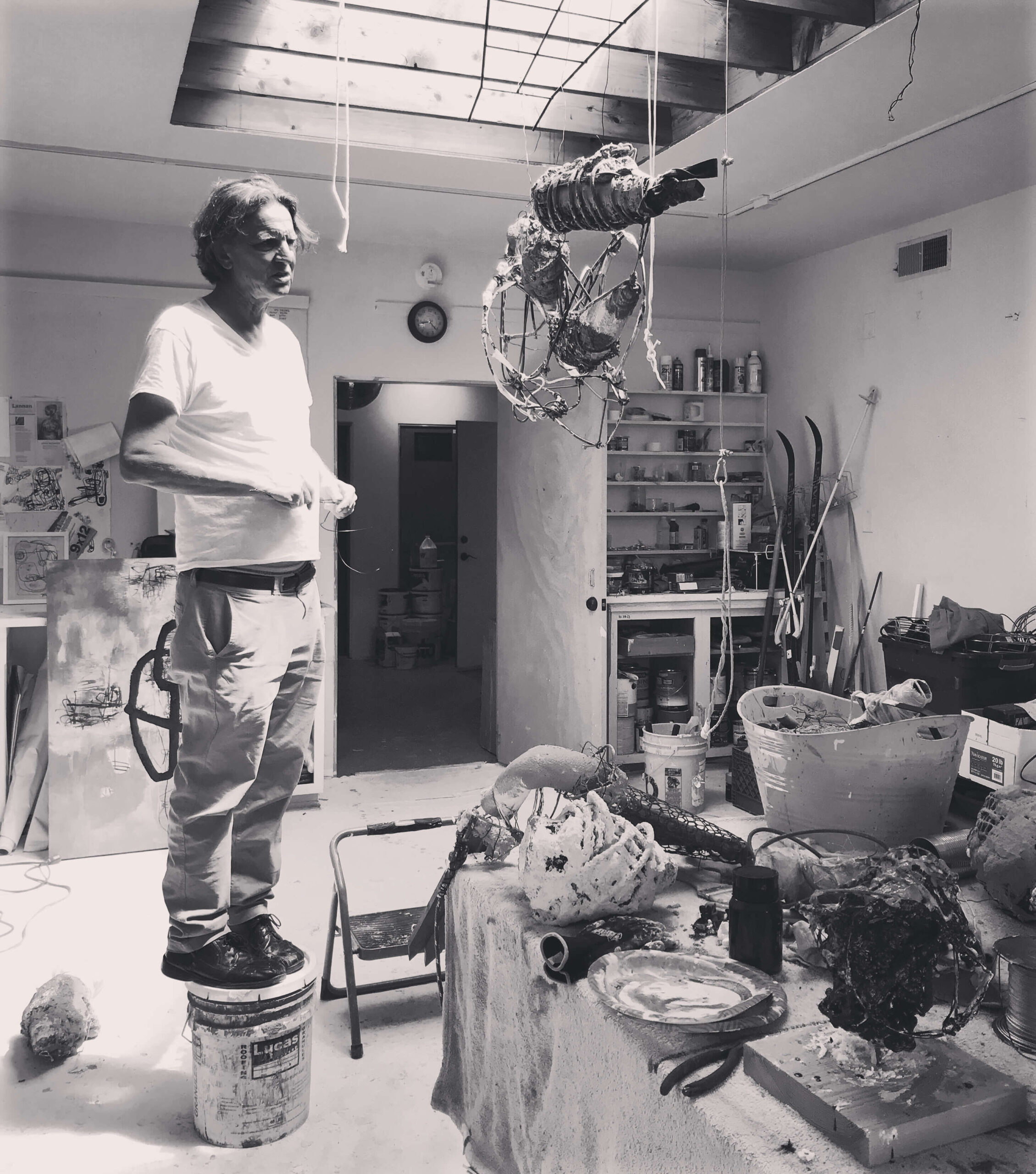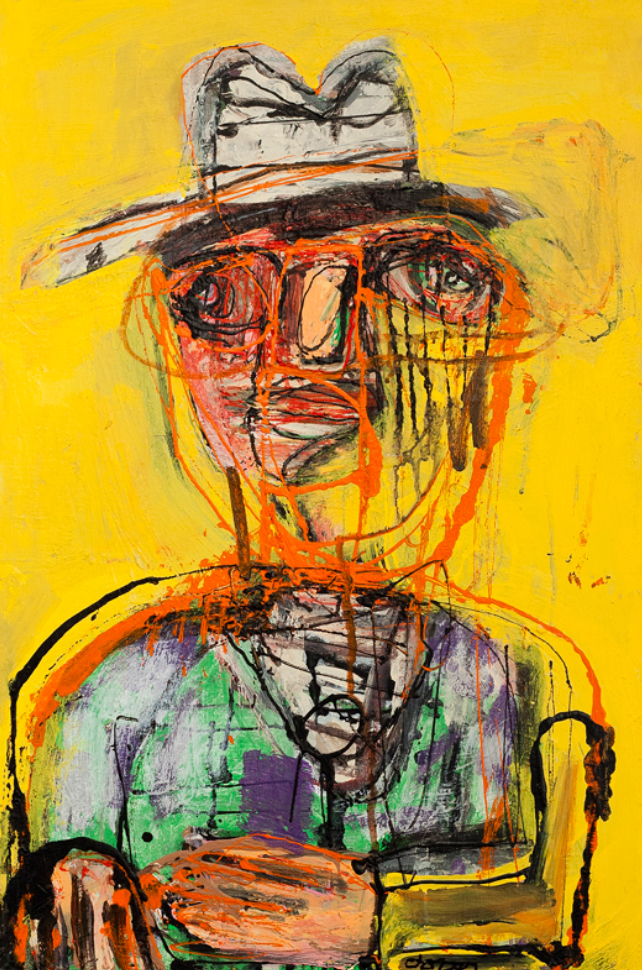ABOUT
JOHN BARKER
Santa Fe artist John Barker paints energetically and prophetically. He is a decidedly 21st century artist, a fervent creator of images that possess a singularly accessible humanity-and as such his works are rife with neuroses and noise. His paintings are like visual manifestations of a tenaciously busy mind: per fervid worlds where the vibrant, even volatile, always trumps the restrained and austere. His is a free-wheeling pictorial language, in which irrelevance is examined and ultimately championed. Barker made up the word ‘Distractionism’ to describe his work, and indeed his compositions sometimes seem spacey or preoccupied. The term is both an affectionate refutation and an earnest exoneration of our distinctly contemporary, dwindling attention spans-a serious and goofy send-up to the artist’s multi-faceted, multi-tasking life. It’s perhaps paradoxical, then, that Barker’s buzzing, electric portraits require such keen attention.
In them, areas of bright color are populated with keyed-up figures that look scratched and scrawled into and across the surface. His environments are heated and nervy, characteristic of an artistic practice that possesses its own determined-if absentminded-natural order, whose rules are blessedly numbered and constantly in flux. Though Barker works in an acutely expressionist vein, there is much to be gained from exploring his forays into figuration. The subject he paints aren’t exactly complete forms, but rather accretions of dissonant shapes, possibilities, and ideas. Their alternate moods of agitation, excitation, or even intoxication are infused throughout with an unpremeditated, unwieldy dynamism-a thrilling primitivism that places them apart from any known genre or established paradigm.

Photo by Juliane Worthington

The Artist, acrylic on canvas, 30″ x 20″
His works are cunning and adult, but often rendered with the gestural urgency of a young child. They teeter deliciously on the tightrope of figurative and abstraction, where a coherent narrative is marvelously elusive. Barker’s characters can seem like marginal ones: misfits with disproportionate and jarringly intense features, whose limbs and curves are made many times over by frenetic markings. Though Barker most often paints people he knows, the figures have universally recognizable attributes, and an implicit vulnerability that’s instantly relatable and endearing. In this way, Barker brilliantly merges individual depictions with the traits that make us all so inexorably and complex human, and meanwhile achieves that often stated but early realized artistic objective, what Leo Sternberg called “fixating thought in aesthetic form, pinning down ethereal conceptions … in vital designs.”
Barker focuses his energies on that which is quintessentially here and now, and accordingly, his portraits feel fantastically alive. His subjects are in turns focused and frazzled: tricksters that crackle and hum with irrefutably human personalities. Cords of paint twist and overlap in imitation of speech or thought, like phantoms of future or past ideas made visible. These dashed markings appear as sparks and halos; protean elements that hover and dance around Barker’s figures. This lends them a peculiar shape-shifting quality that takes place before the viewer’s very eyes and perhaps helps to explain why so many of the artist’s portraits rebuke any attempt at classification. They exist decidedly apart from explanation, a potentially disorienting sort of anti-thesis that in fact offers multitudinous interpretive possibilities. In moment, a painting’s thrust can shift from figurative to densely abstracted, modified with text and photos that riff and jive with the figures, affording us unfettered access to them, and ultimately, to the artist himself. John Barker makes paintings that are indicative of a wondering, wandering mind, yet they exude an illuminated clarity specific to the intimate poetry of personal experience. They are deeply felt visual expressions that acknowledge an informed acceptance of modern reality’s irrational, constantly shifting focus.
Santa Fe artist John Barker paints energetically and prophetically. He is a decidedly 21st century artist, a fervent creator of images that possess a singularly accessible humanity-and as such his works are rife with neuroses and noise. His paintings are like visual manifestations of a tenaciously busy mind: per fervid worlds where the vibrant, even volatile, always trumps the restrained and austere. His is a free-wheeling pictorial language, in which irrelevance is examined and ultimately championed. Barker made up the word ‘Distractionism’ to describe his work, and indeed his compositions sometimes seem spacey or preoccupied. The term is both an affectionate refutation and an earnest exoneration of our distinctly contemporary, dwindling attention spans-a serious and goofy send-up to the artist’s multi-faceted, multi-tasking life. It’s perhaps paradoxical, then, that Barker’s buzzing, electric portraits require such keen attention.
In them, areas of bright color are populated with keyed-up figures that look scratched and scrawled into and across the surface. His environments are heated and nervy, characteristic of an artistic practice that possesses its own determined-if absentminded-natural order, whose rules are blessedly numbered and constantly in flux. Though Barker works in an acutely expressionist vein, there is much to be gained from exploring his forays into figuration. The subject he paints aren’t exactly complete forms, but rather accretions of dissonant shapes, possibilities, and ideas. Their alternate moods of agitation, excitation, or even intoxication are infused throughout with an unpremeditated, unwieldy dynamism-a thrilling primitivism that places them apart from any known genre or established paradigm.
His works are cunning and adult, but often rendered with the gestural urgency of a young child. They teeter deliciously on the tightrope of figurative and abstraction, where a coherent narrative is marvelously elusive. Barker’s characters can seem like marginal ones: misfits with disproportionate and jarringly intense features, whose limbs and curves are made many times over by frenetic markings. Though Barker most often paints people he knows, the figures have universally recognizable attributes, and an implicit vulnerability that’s instantly relatable and endearing. In this way, Barker brilliantly merges individual depictions with the traits that make us all so inexorably and complex human, and meanwhile achieves that often stated but early realized artistic objective, what Leo Sternberg called “fixating thought in aesthetic form, pinning down ethereal conceptions … in vital designs.”
Barker focuses his energies on that which is quintessentially here and now, and accordingly, his portraits feel fantastically alive. His subjects are in turns focused and frazzled: tricksters that crackle and hum with irrefutably human personalities. Cords of paint twist and overlap in imitation of speech or thought, like phantoms of future or past ideas made visible. These dashed markings appear as sparks and halos; protean elements that hover and dance around Barker’s figures. This lends them a peculiar shape-shifting quality that takes place before the viewer’s very eyes and perhaps helps to explain why so many of the artist’s portraits rebuke any attempt at classification. They exist decidedly apart from explanation, a potentially disorienting sort of anti-thesis that in fact offers multitudinous interpretive possibilities. In moment, a painting’s thrust can shift from figurative to densely abstracted, modified with text and photos that riff and jive with the figures, affording us unfettered access to them, and ultimately, to the artist himself. John Barker makes paintings that are indicative of a wondering, wandering mind, yet they exude an illuminated clarity specific to the intimate poetry of personal experience. They are deeply felt visual expressions that acknowledge an informed acceptance of modern reality’s irrational, constantly shifting focus.

Photo by Juliane Worthington

